This is a great example of macrotia ear reduction surgery that highlights how patients will look within several weeks of their surgical procedure.
I happen to be one of the few plastic surgeons in the United States who offers macrotia ear reduction surgery. This stems from my exclusive experience in performing cosmetic ear reshaping (otoplasty) on a very regular basis. As a result of my expertise in other types of cosmetic ear surgery, I developed my own techniques to help patients seeking actual reduction in the size of their ears – termed macrotia, or scapha reduction, surgery.
What is the Scapha?
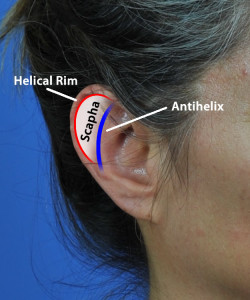 So what is the scapha of the ear? The adjacent photo diagram will help to illustrate what I am referring to in terms of the scapha. The scapha of the ear is the flattened area that is situated between the helical rim (the outer border of the ear) and the antihelix (a natural ridge or elevation indicated by the blue line).
So what is the scapha of the ear? The adjacent photo diagram will help to illustrate what I am referring to in terms of the scapha. The scapha of the ear is the flattened area that is situated between the helical rim (the outer border of the ear) and the antihelix (a natural ridge or elevation indicated by the blue line).
In some patients, the scapha is simply too large, or overdeveloped. This type of scapha enlargement results in an ear that looks too big in terms of vertical height as well as width. Believe it or not, this type of problem is more common than you would think. In fact, many patients consult with me thinking they need to have their ears pinned back (more traditional otoplasty surgery). But after examining them, it is more obvious the scapha is enlarged, which needs an entirely different type of surgery.
Ear Reduction Surgery
Macrotia is ear reduction surgery – taking an excessively larger ear and making it smaller. It is the essentially the opposite of microtia surgery where a new ear is being created or built. The reality is that many doctors still frequently mistake macrotia surgery for microtia surgery, which tells you that very few board certified plastic surgeons know how to correct this problem. In fact, I am one of the very surgeons in the entire nation who has established expertise in macrotia scapha reduction ear surgery. Today, I see patients flying in to San Diego from all over the country to have macrotia ear reduction surgery by me.
Macrotia Ear Reduction
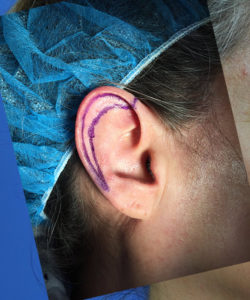 This case example shows – more visually – why and how the ear reduction surgery is performed. It is essentially done for patients who have a large scapha – the region indicated above. The adjacent photo shows how the scapha was reduced in this particular case. These represent the preoperative markings showing how much of the ear cartilage and skin was going to be removed. There are actually several different techniques that can be used to accomplish a similar goal. This includes a number of variations in terms of incision placement. I happen to utilize all of the different methods for ear reduction surgery and make an individualized decision for each and every patient. Once the excess skin and cartilage have been excised (removed), the perimeter of the ear (the helical rim) is then reattached to help restore proper shape and form.
This case example shows – more visually – why and how the ear reduction surgery is performed. It is essentially done for patients who have a large scapha – the region indicated above. The adjacent photo shows how the scapha was reduced in this particular case. These represent the preoperative markings showing how much of the ear cartilage and skin was going to be removed. There are actually several different techniques that can be used to accomplish a similar goal. This includes a number of variations in terms of incision placement. I happen to utilize all of the different methods for ear reduction surgery and make an individualized decision for each and every patient. Once the excess skin and cartilage have been excised (removed), the perimeter of the ear (the helical rim) is then reattached to help restore proper shape and form.
Ear Reduction Early Healing
These photos here show what early healing looks like following macrotia ear reduction surgery. In fact, these photos are taken within 14 days of the operation. I provide them here so that prospective patients can get a real sense of how the healing process unfolds following macrotia surgery. Yes – you can see how the ear still looks quite red and inflamed. However, this discoloration and swelling will settle down significantly over the following weeks to ultimately assume a natural color with normal surface contour. If you look along the upper portion of the ear you can see a short, raised area of skin. This corresponds to the area where a cut was made across the helical rim of the ear in order to help remove the excess tissue. This is intentionally raised up using deeper sutures – a technique called wound eversion. This, too, will settle down with time and eventually assume a more natural, smooth contour.
Overall, what can really appreciate in these early healing photos is how her ear now looks smaller. That is because, indeed, it is a smaller ear after undergoing macrotia surgery. The distance across the scapha region has now been nicely reduced and it assumes a more normal size and shape. In many cases, we can reduce an ear like this upwards of one (1) centimeter, if not more in rare circumstances. To some of you that may not sound like a lot – but when it comes to the ear that can translate into a reduction of 10-15% of the size. Plus, keep in mind that macrotia ear reduction surgery like this will also help create a more favorable shape.
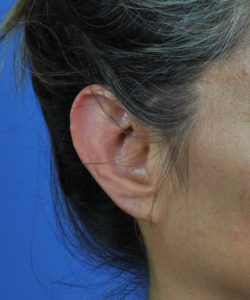
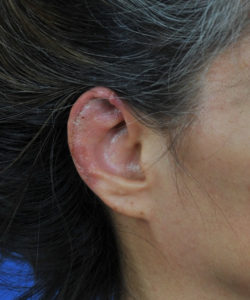
Longer-Term Healing
These photos here show what the ear looks like several months out from macrotia ear reduction surgery. As you can see – compared with the early healing process – the ear now looks less inflammed (less red) with more definition starting to emerge in terms of the natural surface contour. With additional time, the ear will heal some more to the point where there is even less signs of having had macrotia surgery.
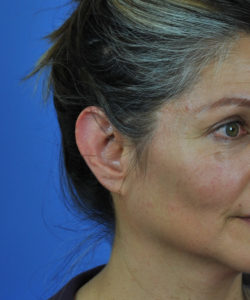
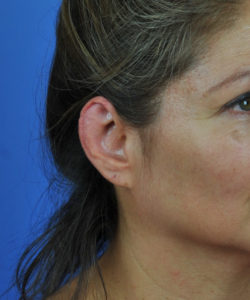
Macrotia Ear Reduction Consult
If you have large ears, or macrotia, and think that ear reduction surgery by benefit your cosmetic appearance, do not hesitate in contacting my office today to discuss your options.
Dr. John Hilinski has either authored or reviewed and approved this content.



